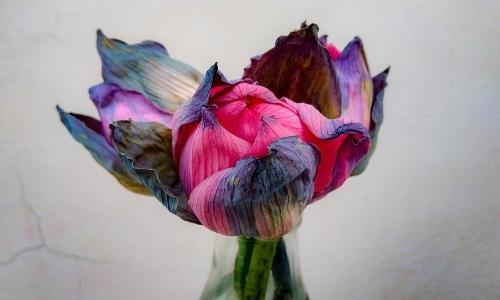So you buy some fresh cut flowers for your home and pop them straight in the vase on the dinner table.
But the next day some are looking rather droopy and sorry for themselves.
But how can this be?!
Don’t worry, it happens to us all. You’ve come to the right place.
Here’s our top tips for reviving your cut flowers to help them go the distance!

Wilted Flowers
Droopy flower heads can give us all the heebie-jeebies. However, it just means that the flowers aren’t getting enough water to the head. This can be because of a trapped air bubble in the stem.
Here’s what to do:
- Clean your vase and add fresh cold water and flower food.
- Cut 6-7cm off the bottom of your wilted flowers at an angle. Use sharp secateurs rather than scissors as even sharp scissors may crush the stem.
- If the flowers have a heavy head, like a rose, trim the stem at an angle. Then take a piece of newspaper and snuggly make a cone wrap round the heads. Stand them in water for a good few hours, overnight is best, for a good long drink. After that, take the paper off, trim the stems at an angle again and place back in the vase.
- Flowers like hydrangea, which have heavy heads and sensitive, light petals, lose lots of water through their petals. If yours have wilted, fill your sink up with cool water and fully submerge the whole head
- After 10 minutes take it out and shake off the excess water, trim the stem at an angle and wait for the bloom to transform back into its former glory. This normally takes a number of hours so relax and have some tea and a nap in the meantime. If this trick doesn’t work, there’s a chance they may have been left a bit too long.


Brown Petals
It’s completely natural to find brown petals on flowers as time goes on. Best thing to do is to remove the individual petal as this will allow the flower to give more energy to the petals that need it. Taking off brown petals will also stop it spreading quickly to the rest of the flower too.


Dead Heads
Many flowers like lilies, snapdragons, spray roses and others have multiple flowering heads on one stem. Most of these flowers (although there are exceptions) also bloom from the bottom up, which means that generally it will always be the lower flowers that will pop first.
Once a bloom has died back, cut it off near the stem to remove the whole head. Dead heading is quite important for two reasons. The first is that the flower will then redirect the energy it has to the blooms next up on the stem. Secondly, dying blooms release Ethylene which is a gas that makes flowers decay faster.


We hope this has dispelled some mysteries for you!
If you need any assistance with specific flowers, please feel free to send us an email and we’ll be happy to help.


